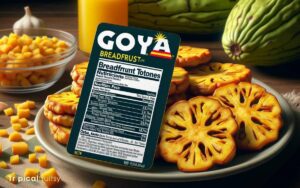Difference Between Breadnut and Breadfruit: Comparison!
Breadnut (Brosimum alicastrum) and breadfruit (Artocarpus altilis) are tropical staples often confused due to their similar names and appearances. Despite their commonalities, they are distinct species with unique characteristics.
Breadnuts, also known as Maya nuts, originate from the Brosimum genus and are encased in a spiky shell, whereas breadfruits, belonging to the Artocarpus genus, have a more globular shape with a patterned skin.
Nutritionally, breadnuts are richer in proteins and fats, while breadfruits provide a higher carbohydrate content, making them an excellent energy source. In the culinary realm, these fruits offer versatility but require different preparation methods.
Understanding their botanical origins, physical attributes, and the roles they play in various cuisines can clarify misconceptions and guide informed choices for those exploring these tropical delicacies.
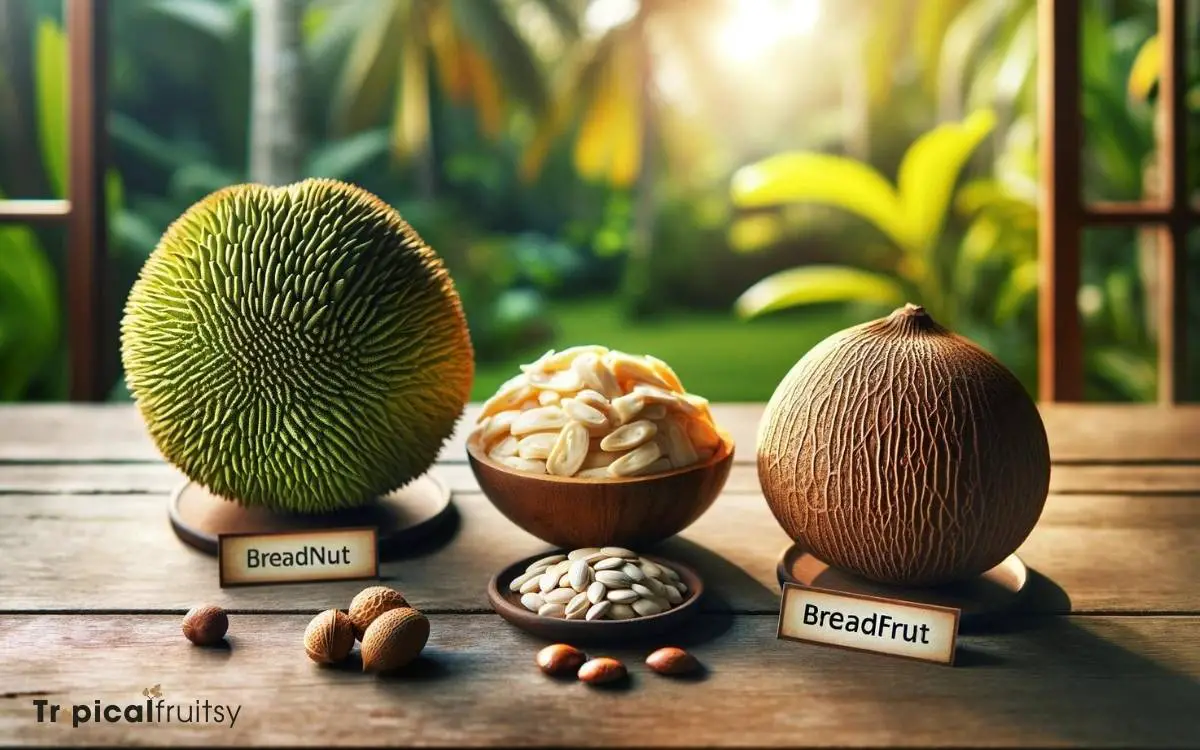
Key Takeaway
Comparison Table: Breadnut vs Breadfruit
| Feature | Breadnut | Breadfruit |
|---|---|---|
| Scientific Name | Brosimum alicastrum | Artocarpus altilis |
| Origin | Native to Central America, Mexico, and the Caribbean | Native to the South Pacific and the Malay Peninsula |
| Appearance | Smaller and harder, with a spiky green shell | Larger, with a smooth or slightly spiky green skin |
| Taste | Nuttier and richer in flavor | Milder, somewhat like potato or fresh bread |
| Nutritional Content | Rich in protein, vitamins, and minerals | High in carbohydrates, dietary fiber, and vitamins |
| Culinary Uses | Often roasted or boiled; seeds are edible | Used as a vegetable in various dishes; can be roasted, fried, or boiled |
| Cultural Significance | A staple food in Mayan and Aztec cultures | A staple food in many Pacific Islands |
Botanical Origins
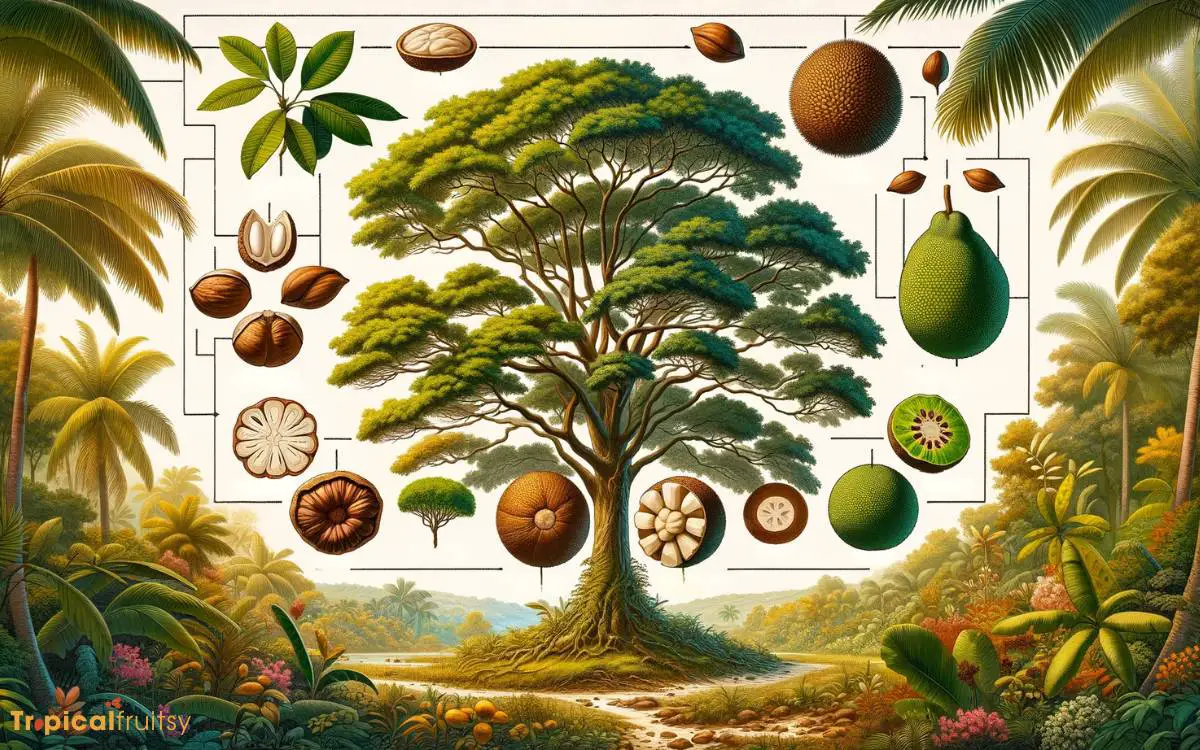
Within the family Moraceae, breadnut (Brosimum alicastrum) and breadfruit (Artocarpus altilis) are distinct species, each with unique botanical origins that trace back to different regions within the tropics.
The breadnut, indigenous to the mesoamerican region, has been a staple in the diet of various indigenous cultures, evidencing its long-standing ecological and cultural significance.
Conversely, the breadfruit, with its genesis in the South Pacific and the Malay Peninsula, was disseminated by oceanic voyages, resulting in a wide distribution across tropical regions.
Their divergent evolutionary paths are evident in their morphological differences, such as the breadnut’s hard seeds and the breadfruit’s multiple seedless cultivars.
These adaptations reflect the unique environmental pressures and human selection practices within their respective native habitats.
Physical Characteristics
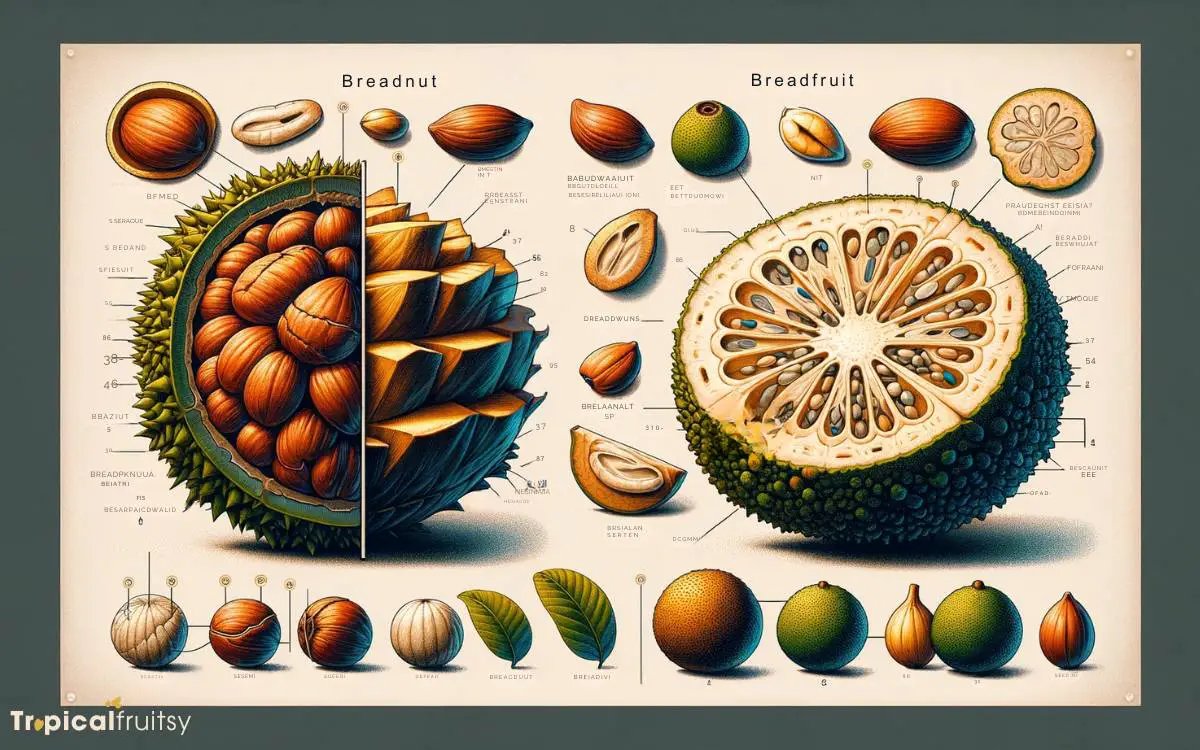
Several physical attributes distinguish breadnut from breadfruit, including differences in fruit size, seed presence, and leaf morphology.
Analyzing these characteristics facilitates a clearer understanding of each species. Breadnut fruits generally contain multiple seeds, which makes them seedier than breadfruit.
In contrast, breadfruit typically has few to no seeds, depending on the variety. The size of the fruit is another distinguishing factor, with breadfruit often being larger.
Moreover, the leaves of each plant exhibit distinct patterns and structures which can aid in identification.
| Characteristic | Breadnut | Breadfruit |
|---|---|---|
| Seed Presence | Seedy | Few to none |
| Fruit Size | Smaller | Larger |
| Leaf Morphology | Varied | Consistent |
Nutritional Content
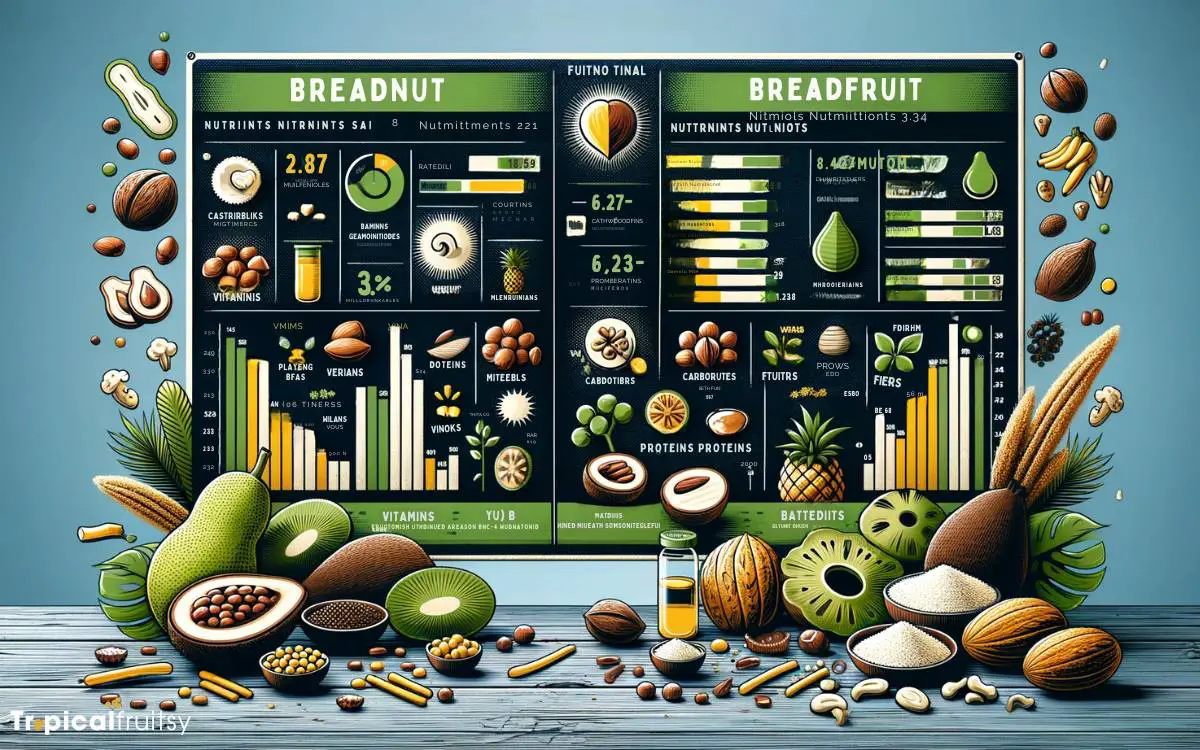
Nutritional analysis reveals that both breadnut and breadfruit offer a rich array of vitamins and minerals, though their profiles exhibit notable differences.
Breadfruit is distinguished by its higher water content, contributing to its lower calorie count per serving. It is a significant source of complex carbohydrates, dietary fiber, and vitamin C, essential for immune function and antioxidant protection.
Conversely, breadnuts provide a more concentrated source of proteins and fats, including heart-healthy monounsaturated fats.
They are notably rich in vitamin A, crucial for vision and immune health, and vitamin B complex, which is imperative for metabolic processes.
Both foods contain minerals such as potassium, which aids in maintaining electrolyte balance and muscular function, and magnesium, involved in numerous biochemical reactions in the body.
Culinary Applications

Transitioning from their nutritional profiles to culinary uses, both breadnut and breadfruit exhibit versatility in various global cuisines, serving as staples in savory dishes and sweet preparations alike.
The culinary applications of these tropical fruits are as varied as their cultural contexts:
Breadfruit:
- Savory: Often used as a potato substitute, breadfruit is roasted, boiled, or fried to complement meat dishes or served in stews and curries.
- Sweet: Ripe breadfruit is sometimes used in desserts, such as pies and puddings, where its natural sweetness is enhanced.
Breadnut:
- Grains: The seeds are boiled and consumed similarly to chestnuts or are ground into flour for breadmaking.
- Meat Substitute: With a meaty texture, the cooked seeds are incorporated into vegan and vegetarian recipes as a protein source.
Harvesting and Seasonality
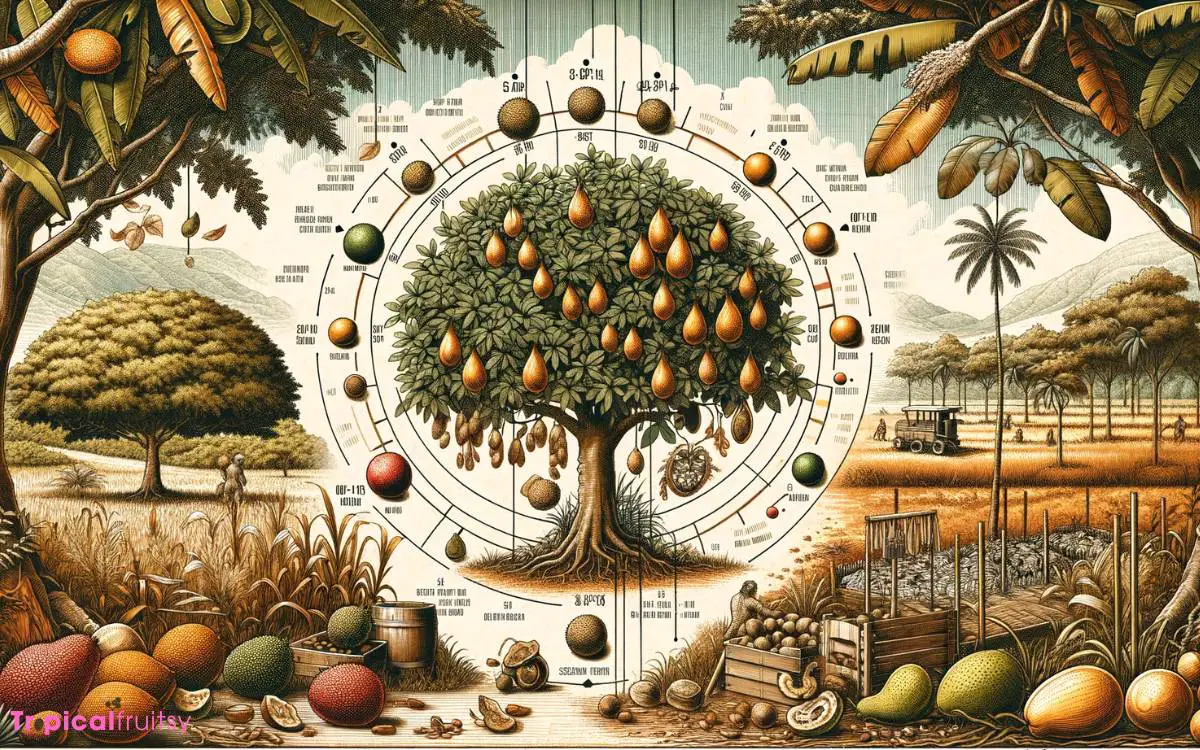
The phenological patterns of breadnut and breadfruit significantly influence their optimal harvest times, reflecting adaptations to their respective environments.
While breadfruit typically exhibits a pronounced seasonal yield, peaking in specific months, breadnut production may not align as closely with seasonal changes, suggesting a varied adaptive reproductive strategy.
Understanding the nuances of seasonal availability between these two species is crucial for effective agricultural planning and ensuring year-round food security in regions where they are cultivated.
Optimal Harvest Times
Understanding the optimal harvest times for both breadnut and breadfruit is essential, as each has a specific seasonality that affects flavor and texture.
The ripeness of these fruits is not merely a measure of edibility but also determines their culinary applications and nutritional value.
Breadnut (Brosimum alicastrum)
- Typically harvested: Late summer to early fall
- Indicators of ripeness: The shell turns from green to yellow-brown, and the fruit softens
- Peak seasonality: Varies by region, often aligned with the wet season
Breadfruit (Artocarpus altilis)
- Typically harvested: Throughout the year in tropical climates, with peaks in summer and early fall
- Indicators of ripeness: Skin transforms to a yellow-green hue, and the fruit yields to gentle pressure
- Peak seasonality: Influenced by rainfall patterns, often occurring twice annually
This precise timing ensures the highest quality of the harvested produce.
Seasonal Availability Differences
Regarding the seasonal availability of breadnut and breadfruit, distinct differences arise from their respective ecological adaptations and geographical distributions.
Breadfruit typically has a primary bearing season when climatic conditions such as temperature and rainfall align optimally, fostering a prolific yield.
This season usually corresponds with the wetter months, which can vary based on the specific region’s climate patterns.
On the other hand, breadnut trees may exhibit a more sporadic fruiting pattern, though they tend to mature in late summer to fall.
The phenological cycles of these species are influenced by their unique genotypes and environmental interactions, resulting in their dissimilar harvesting windows.
Consequently, understanding these temporal patterns is crucial for effective cultivation and utilization of breadnut and breadfruit resources.
Cultural Significance

Although both breadnut and breadfruit hold important places in tropical cultures, their roles and symbolic meanings vary significantly across different societies.
Breadfruit, for instance, is often associated with abundance and community due to its large size and the substantial nourishment it provides. Breadnut, while less globally recognized, carries its own set of cultural significances.
Breadfruit:
- Symbolizes hospitality in some Pacific Island cultures.
- Integral to traditional agroforestry systems, reflecting a harmonious relationship with nature.
Breadnut:
- Viewed as a ‘tree of life’ in certain Mesoamerican societies for its versatile uses.
- Connected to ancient rituals and may represent fertility or sustenance.
This analysis reveals that both plants are not only food sources but also carry deep cultural narratives that underscore their value beyond mere sustenance.
Availability and Access

While breadfruit is widely cultivated in various tropical regions, breadnut trees are less commonly found and often grow wild in their native habitats.
This disparity in cultivation and growth patterns indicates that breadfruit is more accessible and can be more readily integrated into agricultural systems.
Its propagation through root cuttings or seeds allows for easier dissemination among farmers and communities.
Conversely, the breadnut, with its more sporadic occurrence, presents challenges for systematic cultivation and widespread distribution.
The availability of breadnuts is often contingent on the presence of natural stands or historical plantings, which may not be systematically managed or harvested.
This difference in availability has implications for the utilization and conservation of genetic resources within these species.
As we consider the accessibility of these trees, we also must evaluate their environmental impact.
Are Breadnut and Jackfruit Related to Breadfruit in Any Way?
Yes, there is a connection between breadnut and jackfruit, as both are related to the breadfruit. In a jackfruit vs breadfruit comparison, all three belong to the same plant family, Moraceae. While they share some similarities, each fruit has its own unique flavor and uses in various cuisines.
Environmental Impact
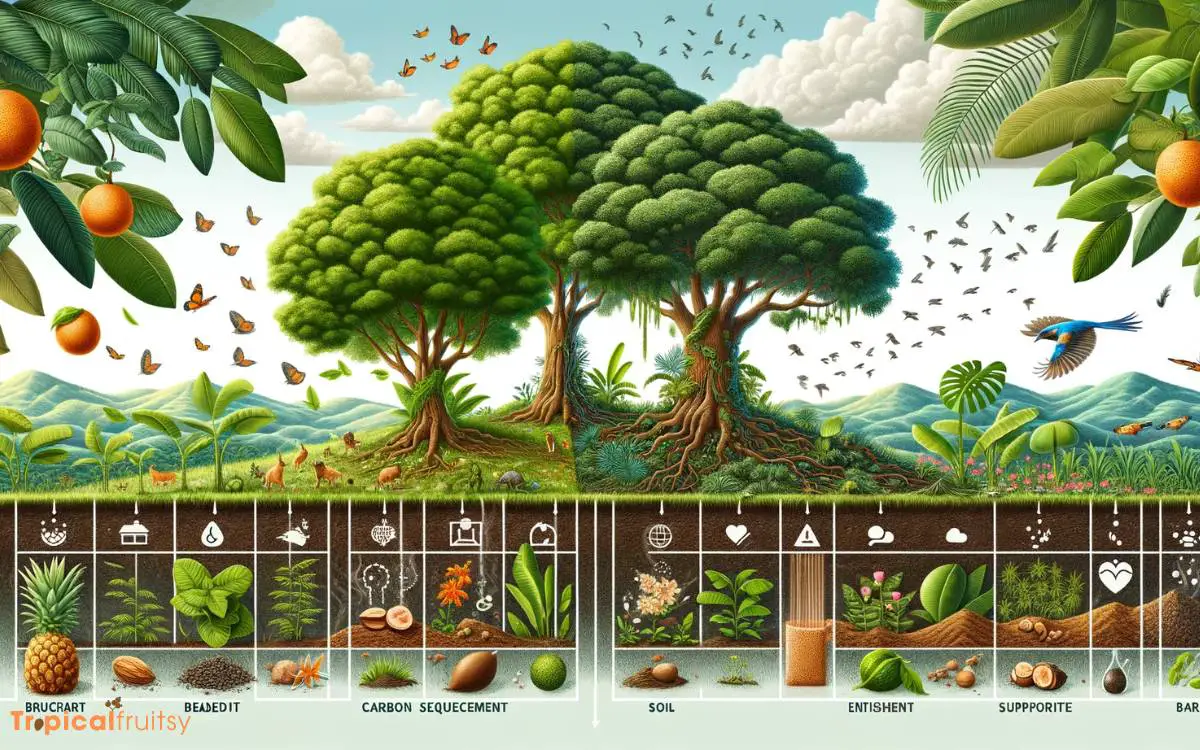
The sustainability of breadfruit and breadnut cultivation plays a critical role in the environmental impact of these species within tropical ecosystems.
Both crops are lauded for their low-maintenance requirements and minimal need for agrochemicals, which contributes to a relatively benign environmental footprint.
Scientific analysis of their cultivation practices reveals:
Carbon Sequestration:
- Breadfruit trees are perennial, allowing them to absorb carbon dioxide throughout their long lives.
- Breadnut trees also contribute to the carbon cycle, enhancing the carbon sink capabilities of tropical forests.
Biodiversity:
- Breadfruit agroforestry supports diverse understory growth, promoting habitat complexity.
- Breadnut cultivation, often in mixed-crop systems, encourages ecological balance and species diversity.
These aspects underscore the potential of breadfruit and breadnut to be integral components of sustainable agriculture within their native and introduced ranges.
Conclusion
The breadnut and breadfruit are distinguishable species with unique botanical origins, physical characteristics, and nutritional profiles.
Each plays a distinct role in culinary traditions, with specific harvesting times and cultural relevance. Their availability and environmental impacts reflect intricate interactions with ecosystems.
As the adage goes, ‘Variety is the spice of life,’ and these fruits exemplify the rich diversity within the plant kingdom that supports and enriches human diets.




